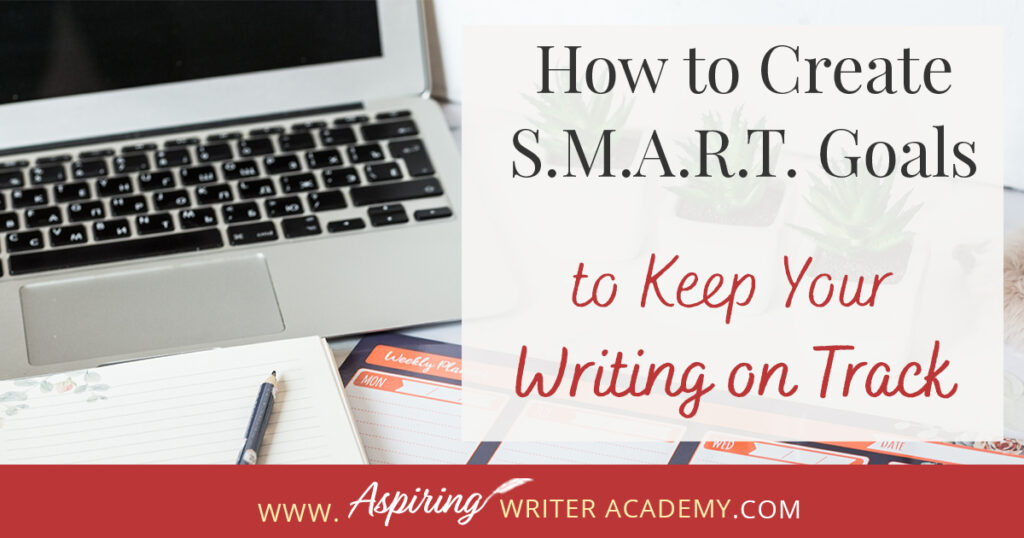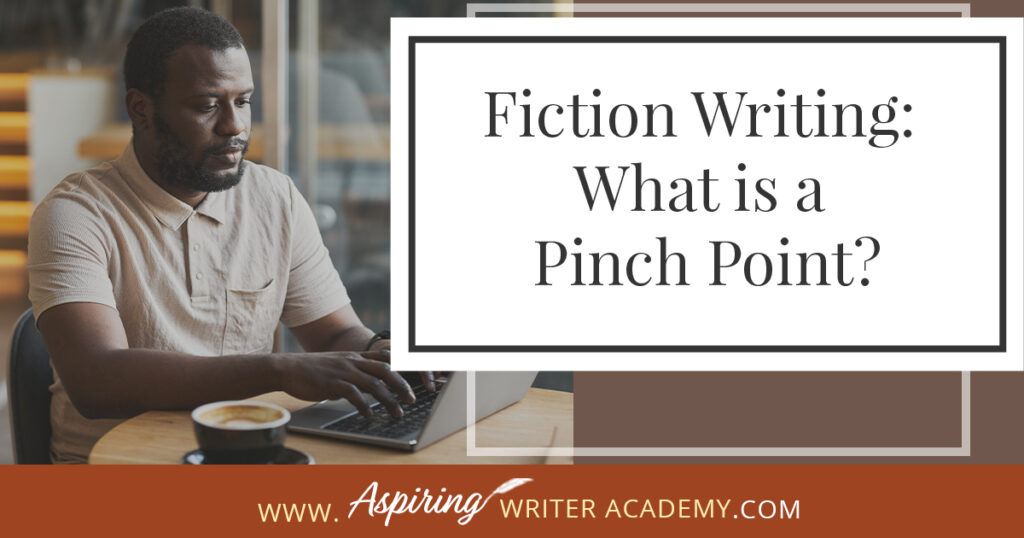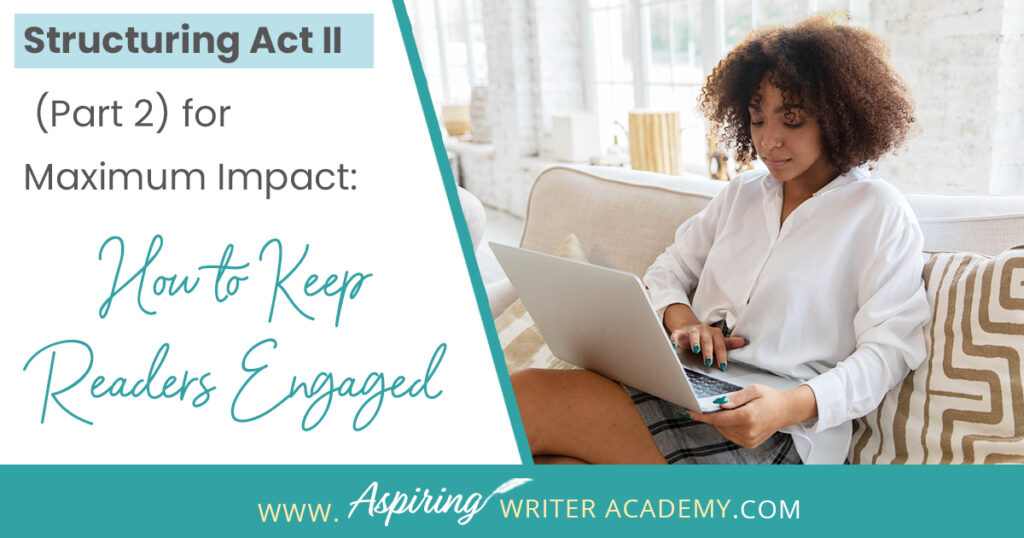Posts Tagged ‘Writing’
Fiction Writing: What is a Character’s ‘Ordinary World?’
Does your character live in a world where animals talk? Does he fly a spaceship to work? Or does his ‘ordinary world’ include monsters or a unique culture with specific rules and questionable beliefs?
In our post, Fiction Writing: What is a Character’s ‘Ordinary World?’ we show you how to give the reader the set-up pieces needed to understand your character and how he fits in with his environment before the external events of the plot unfold.
Read MoreHow to Create S.M.A.R.T. Goals to Keep Your Writing on Track
Do you set goals with your writing only to have them derailed? Do you have trouble finishing a novel or with time management in general? How is an author supposed to maintain a personal life, do household chores, and write—publish—promote their stories without feeling overwhelmed or run ragged? In our post, How to Create S.M.A.R.T. Goals to Keep Your Writing on Track, we show you how to eliminate frustration and hit the needed milestones to write and finish your fictional story.
Read MoreHow to Use Themes in Your Fictional Story
Do you know your story’s theme? Or the difference between a theme and a moral? A theme is the glue that holds your story together and without one, your readers may find themselves scratching their heads wondering what your story is really about.
In our post, How to Use Themes in Your Fictional Story, we give examples of theme, how to weave theme into your story for greater focus, and the right and wrong way to reveal theme at the end of your fictional masterpiece.
Fiction Writing: What is a Pinch Point?
As an aspiring writer, it is hard enough to learn how to develop an interesting character and plot a fictional story that captures a reader’s interest. But what is a pinch point? How many are there in a fictional story and how are they used? Many seasoned writers do not even know!
In Fiction Writing: What is a Pinch Point? we demystify the term and show how inserting significant emotion-packed pinch points into your fictional story can help motivate characters to pursue their story goal.
Read MoreLearn to Plot Fiction Writing Series: Story Analysis of the movie “Marry Me”
The best way to learn story structure is to analyze good stories. Can you readily identify each plot point in every movie you see or book you read? Or do terms like ‘inciting incident,’ ‘midpoint reversal,’ and ‘black moment’ leave you confused? In our Learn to Plot Fiction Writing Series: Story Analysis of the movie “Marry Me” we show you how to recognize each element and provide a Free Plot Template so you can draft satisfying, high-quality stories of your own.
Read MoreHow to Find a Writing Group: Tips for New Authors
Are you eager to connect with like-minded authors and build meaningful writing friendships? Our post How to Find a Writing Group: Tips for New Authors is tailor-made for you. Writing does not have to be a solitary journey. It can be filled with friends who also aspire to take their writing to the next level. There are many groups that authors can join to help them with motivation, accountability, and guidance in their writing careers.
Read More7 Tips for Writing a Story Synopsis
Ask any writer about the dreaded story ‘synopsis’ and you will most likely hear lots of moans and groans. How do you condense the plot of an entire book into just 2 or 3 pages? What should be included? How should it be formatted? How should characters be introduced?
Join us as we discuss 7 Tips to Write a Story Synopsis to help simplify the process so that you can confidently and successfully write a story synopsis with ease.
Read MoreNaNoWriMo: How to Write a 50k Word Novel in 30 Days
November is National Novel Writing Month, a time when thousands of writers around the world will attempt to write a 50,000-word novel in 30 days. You can sign up for the free challenge at https://nanowrimo.org/ and use their digital graphs and charts to track your progress and keep you accountable each day. But how can you write a novel so quickly? In our post, NaNoWriMo: How to Write a 50k Word Novel in 30 Days, we give you a list of helpful tips to keep you on target and finish a winner!
Read MoreHow to Create a Fictional Character in 5 Steps
If you are just starting to write a novel, you may have come across character questionnaires to help you brainstorm basic information for your story cast, but how do you truly flesh out your characters on a deeper level? How do you make your characters jump off the page and feel “real?”
In How to Create a Fictional Character in 5 Steps, we give you more than just the average list of questions to think about so that you can create characters your readers will love.
Read MoreThe Writing Life: Quotes to Embrace the Journey
A writer’s life can be filled with moments of joy, frustration, and everything in between. Whether you’re a new writer or an experienced author, everyone faces writing slumps and lows and can often use inspiration to keep the motivation to continue writing. It’s important to remember that being an author and writing books is a journey and we’ve compiled a list of quotes to help inspire you to embrace the ups and downs of writing books, to find the beauty in the process, and to never give up on your dreams.
Read MoreFiction Writing: What is the ‘Black Moment?’
The ‘Black Moment’ is a major turning point in a fictional story where the main characters lose hope. They have struggled to achieve a specific goal and at this dark, bleak moment something happens, either triggered by the opposition or by their own weaknesses that cause them to believe they’ve failed and ‘all is lost.’
In Fiction Writing: What is the ‘Black Moment?’ we give you tips and illustrative examples to help you create a fabulous Black Moment scene of your own.
Read MoreFiction Writing: What is the ‘Man in the Mirror Moment?’
Do you have a ‘man in the mirror moment’ in your fictional novel? Can you readily identify this pivotal moment in movies or other author’s fiction? Not only is it a turning point in the protagonist’s character arc, but it drives the external storyline forward during the second half of Act II.
In our post, Fiction Writing: What is the ‘Man in the Mirror Moment?’ we explain what this term means and how you can strategically use it to strengthen your entire novel.
Read MoreLearn to Plot Fiction Writing Series: Story Analysis of the movie “The Greatest Showman”
The best way to learn story structure is to analyze good stories. Can you readily identify each plot point in every movie you see or book you read? Or do terms like ‘inciting incident,’ ‘midpoint reversal,’ and ‘black moment’ leave you confused?
In our Learn to Plot Fiction Writing Series: Story Analysis of the movie “The Greatest Showman” we show you how to recognize each element and provide a Free Plot Template so you can draft satisfying, high-quality stories of your own.
Read MoreHow to Delete Dialogue Tags (He said /She said) in Fiction Writing
The goal of writing a fictional novel is to give your readers a unique, emotional experience. However, if there are too many clunky dialogue tag interruptions meant to identify which character is speaking, the reader may become frustrated and put the book down.
In our post, How to Delete Dialogue Tags (He said / She said) in Fiction Writing, you will learn various methods to make the verbal exchanges in your writing smoother, stronger, and more engaging for the reader.
Read MoreHow to Create a Diverse Cast of Characters for Your Fictional Novel
Have you read a book where all the characters sound the same and you have trouble remembering who is who? Without dialogue tags, would you know which fictional character is speaking? How can an author create characters that are unique?
In our post, How to Create a Diverse Cast of Characters for Your Fictional Novel, we show you how to intentionally design characters who contrast with one another in various ways to create additional conflict and raise the tension in the plot.
Read MoreWrite Your First Novel: How Do You Start?
Are you finally ready to write that book you always wanted to write one day? Great! How do you start? Who should be your main character? What will the story be about? Does there have to be a villain? When and where should the story take place?
In our post, Write Your First Novel: How Do You Start? we help you choose your main character, pinpoint the opposition, and create a story that you will be excited to write!
Read MoreDo You Dream of Being a Published Author? (How Bad Do You Want It?)
Many people say they would like to write a book or become a published author but only about 2 percent actually do the work to get it done. If you have the burning passion to write and publish your story and build a writing career, then you will need to take specific steps to separate yourself from the ‘hobbyists.’
In our post, Do You Dream of Being a Published Author? (How Bad Do You Want It?) we give you three tips to help make your dream come true.
Read MoreWho is an ‘Aspiring Writer?’ 3 Tips to Escalate Your Career No Matter What Level You Are At
Are you an ‘aspiring writer?’ Or do you think that term only applies to newbies? It is surprising how many writers sabotage their careers because they think they know everything they need to know while successful writers recognize that you should never stop learning.
In our post, Who is an ‘Aspiring Writer?’ 3 Tips to Escalate Your Career No Matter What Level You Are At, we discuss the habits of successful writers so you can stand out from the crowd and become one too!
Read MoreHow to Write the Midpoint of Your Novel (and Avoid a ‘Saggy Middle’)
Do your novels begin full steam with a lot of energy and momentum only to fizzle out by the book’s middle? If repeated, you may soon have a whole drawer of brilliant starts but no finished projects. So how do you avoid writing a ‘saggy middle?’
In our post, How to Write the Midpoint of Your Novel (and Avoid a ‘Saggy Middle’), we give you a template to slingshot your story over that dreaded hump and straight into the second half so you can keep writing and finally get to ‘The End!’
Read MoreHow to Find a Great Story Idea in 4 Easy Steps
How do you come up with new story ideas for a fictional novel? Do you start with a situation or a character or with a concept, theme, or location? How do you know if you have a solid story idea? What information is needed to get started?
In our post, How to Find a Great Story Idea in 4 Easy Steps, we lay out the four components that will help you create a working story idea that you can turn into a fictional novel.
Read MoreFiction Writing: What is a Plot Hole?
As its name suggests, a plot hole is a missing piece of your novel that trips up your reader. The story is progressing smoothly and then all the sudden something just doesn’t make sense. This breaks trust with your reader, who now finds the story unbelievable.
How do you know if your story has holes in the plot? In Fiction Writing: What is a Plot Hole? we discuss the various kinds of plot holes so you can eradicate them from your writing and keep your audience enthralled.
Read MoreFiction Writing: What is a Character Arc?
In the best stories, the protagonist (main character) undergoes change as he or she struggles to meet challenges, resolve conflict, and achieve the story goal. The character may overcome a weakness or have a change of heart or point of view, but he is not the same person at the end of the story as he was at the beginning. The story-journey changes him.
In our post Fiction Writing: What is a Character Arc? we help you create character change that is both incremental and believable.
Read MoreHow to Write Act III and Finish Your Fictional Story in 5 Steps
What is included in Act III of a Fictional Novel?
In Act III, new information is revealed, prompting the protagonist to make a decision to regather the team or needed resources in preparation for the climax where there will be a face-to-face confrontation with the antagonist or villain, leading to the story resolution.
In our post, How to write Act III and Finish Your Fictional Story in 5 Steps, we simplify the entire process and help you bring your story to a satisfying conclusion.
Structuring Act II (Part 2) for Maximum Impact: How to Keep Readers Engaged
When using the 3-Act-Structure in fiction writing, Act I begins the story, and Act III contains the story ending. But what happens in the middle of the story? Are there specific turning points that should be included?
In Structuring Act II (Part 2) for Maximum Impact: How to Keep Readers Engaged, we cover the key components of the second half of Act II, from the Midpoint Reversal to Plot Point II, to help you create a memorable fictional story to keep readers engaged and turning pages.
Read More101 Quick Writing Tips for Authors and Writers
Writing can be a challenging and rewarding pursuit, but it’s not always easy to know where to start or how to improve your craft. Whether you’re a seasoned author or just starting out, we hope that you can take away something to help you out with your writing journey from our post 101 Quick Writing Tips for Authors and Writers. We hope that some of these tips help you hone your skills, overcome writer’s block, and create compelling stories that captivate your readers.
Read MoreStructuring Act II (Part 1) for Maximum Impact: How to Keep Readers Engaged
When using the 3-Act-Structure in fiction writing, Act I begins the story, and Act III contains the story ending. But what happens in the middle of the story? Are there specific turning points that should be included?
In Structuring Act II (Part 1) for Maximum Impact: How to Keep Readers Engaged, we cover the key components of the first half of Act II from the Inciting Incident to the Novel Midpoint to help you create a memorable fictional story to keep readers engaged and turning pages.
Read More55 Fiction Writing Tips for Novelists
Are you a novelist looking to take your writing to the next level? Writing a novel is hard work, but with the right tips, it doesn’t have to seem so daunting. From structure and characterization to dialogue and word choice, this article will provide you with 55 fiction writing tips to help inspire and give some quick writing advice to help you along your writer journey.
Read More25 Quick Writing Tips for Fiction Writers
Writing fiction is a challenging and rewarding endeavor that requires a combination of creativity, skill, and discipline. Whether you’re a seasoned writer or just starting out, there’s always room for improvement in your craft. In this blog post, we’ll provide you with 25 Quick Writing Tips for Fiction Writers to help you elevate your writing and create compelling stories that captivate your readers. From character development to plot pacing, we hope that these tips will help inspire you to hone your skills and take your writing to the next level.
Read MoreHow to Create Antagonists Who Are Not Villains
A good fictional story will follow the journey of a main character (protagonist) who is trying to achieve a specific goal. The opposition, (or antagonist), will try their best to stop the main character from achieving that goal. The question is why?
What if each point of view is equally valid? What if the antagonist is not a villain?
In our post, How to Create Antagonists Who Are Not Villains, we show you how to write realistic conflict that will intensify your fictional novel.
Read More20 Quick Novel Writing Tips for Beginners
Writing a novel can be an exciting and fulfilling experience, but it can also be overwhelming for beginners. From developing characters to creating a plot, there are many elements to consider when writing a novel. If you’re just starting out on your writing journey, you may be wondering where to begin. In this blog post, we’ve compiled 20 Quick Novel Writing Tips for Beginners to help you get started and stay on track. These tips will provide you with the guidance and inspiration you need to turn your ideas into a compelling and engaging story. So, let’s dive in!
Read More





























